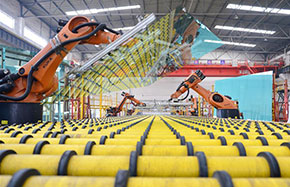The challenges of urbanization
But industries are not necessarily the only option to create jobs and local governments should refrain from attracting homogeneous manufacturers, said Zhou Shijie, vice-mayor of Xinxiang, a booming city in central China's Henan province.
He cited Xinxiang as an example. The government has divided its administration into four tiers: At the top is the central city and at the bottom are the new rural communities. Between are counties and townships. The central city, Xinxiang, highlights grouping development, with a core downtown area and five neighboring sub-towns, each with a designated pillar industry. The counties and townships focus on inner-oriented development, emphasizing redevelopment of the old towns. The new rural communities are designed to locate around the towns. It could save land and public utilities and offer equal public service to rural residents.
Instead of largely homogeneous manufacturing industries, cities should develop various businesses based on their specific advantages, such as tourism, commerce, logistics and specific forms of agriculture, said Zhou.
He is concerned about the current land usage system, which he said is outdated and designed in a way that has increasingly impeded urbanization. According to him, the land management regime is both "stringent" and "relaxed".
"The stringent aspect is that acquiring new land quotas involves many due procedures and takes an extremely long time, which fails to satisfy demand for rapid urbanization on a local level," Zhou said.
"The relaxed aspect is seen in a lack of differential management rules for land with different purposes of use. There is a low threshold for industrial land approval that fails to prohibit many backward industries."
Wang Jiming, vice-mayor of Ezhou, in central China's Hubei province, also stressed the importance of scientific planning and reasonable layout designs for urban areas.
"It is wrong to think the bigger the city's size, the better it is," he said. "Urban development should be modest and respect ecological sustainability."
He said many local governments prefer to build new urban areas while neglecting the maintenance of old towns. For example, the repair of damaged roads and street lamps, the upgrading of the sewerage system and the construction of parks and sports centers are often ignored.
"There is a tendency to stress construction while neglecting management. It is because construction easily demonstrates political achievement while day-to-day management does not," Wang said.
The officials said they are willing to provide more public services so they do not lag behind the physical buildup of the city. But in reality they face many obstacles. Local governments usually are not sufficiently well funded to accomplish the jobs they face and the fast turnover of migrants makes it difficult to offer appropriate services to them.
"The situation is that although the number of migrants is stable, the composition of this stable number is highly fluid," said Zhou. "We are making efforts to address their healthcare and educational demands but, in terms of housing, frankly speaking, we are not able to (tackle the problem)."
Officials who attended the class called for local government initiatives and specific policies catering to local needs.
When an official raised the issue of local initiatives, he was enthusiastically endorsed and the atmosphere turned fervent. "Local experiments should be encouraged. It does not matter that a mistake may be made. On the contrary, mistakes provide experience. What we fear is a little mistake being severely punished, making other people dare not to innovate anymore," an official said.
"China is so diverse, with huge differences within the country. How can one urbanization plan fit all?" asked Zhou.
- Urban planners eye China's cities
- Sustainable urbanization
- China's urban fixed-asset investment up 20.4% in Jan-May
- China's urban unemployment rate remains 4.1%
- China plans urbanization steps
- Reports on shelved urbanization plan untrue
- Urbanization plan not rejected: NDRC
- Creating the modern face of urbanization

























